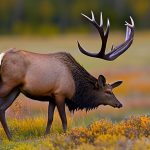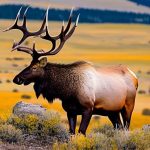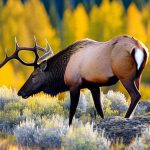Your cart is currently empty!

Top 5 Must-Read Elk Hunting Books for Every Avid Hunter

Elk hunting is a popular and thrilling outdoor activity that has gained a significant following over the years. It involves pursuing and harvesting elk, which are large and majestic animals found in various parts of North America. As an avid hunter myself, I have had the privilege of experiencing the excitement and challenge that comes with elk hunting.
Key Takeaways
- Elk hunting requires knowledge of elk behavior and effective calling techniques.
- Understanding the terrain and having the right gear is crucial for a successful hunt.
- Elk hunting should be done ethically and with conservation in mind.
- Reading top elk hunting books can provide valuable insights and tips.
- Learning from experienced hunters and resources can improve your elk hunting skills.
The Art of Elk Calling
Elk calling is a crucial aspect of elk hunting. It involves mimicking the sounds that elk make to communicate with each other. By using different types of calls, hunters can attract elk and bring them closer for a better shot. There are several types of elk calls, including bugles, cow calls, and calf calls.
Bugles are used to imitate the sound of a bull elk during the rutting season when they are most vocal. This call can be used to locate bulls and establish dominance. Cow calls, on the other hand, imitate the sounds made by female elk. These calls can be used to attract bulls or to communicate with other cows in the area. Calf calls mimic the sounds made by young elk and can be effective in attracting protective cows.
Mastering elk calling takes time and practice. It is essential to learn the different calls and when to use them effectively. Listening to recordings of elk calls and practicing in the field can help improve your skills. Additionally, it is crucial to pay attention to the response of the elk and adjust your calling accordingly.
Understanding Elk Behavior
Understanding elk behavior is key to successful hunting. Elk are social animals that live in herds and have specific habits and patterns. They are most active during dawn and dusk, so it is important to plan your hunts accordingly.
Elk are also creatures of habit and tend to follow established trails and routes. By scouting the area beforehand, you can identify these routes and set up ambush points for a better chance at success. It is also important to be aware of wind direction, as elk have a keen sense of smell and can easily detect human scent.
One common mistake that hunters make is underestimating the intelligence of elk. They are highly adaptable and can quickly learn to avoid areas where they have been hunted before. It is important to vary your hunting locations and techniques to stay one step ahead of them.
Top 5 Elk Hunting Books of All Time
| Rank | Title | Author | Publication Year | Average Rating |
|---|---|---|---|---|
| 1 | The Complete Guide to Hunting, Butchering, and Cooking Wild Game: Volume 1: Big Game | Steven Rinella | 2015 | 4.8 |
| 2 | The Elk Hunter’s Cookbook: A Collection of Recipes and Tips from a Professional Guide’s Kitchen | Kate Fiduccia | 2013 | 4.6 |
| 3 | Elk Hunting: The Ultimate Guide to Hunting Elk | Bob Robb | 2014 | 4.5 |
| 4 | The Elk Hunter’s Guide: A Handbook for Big Game Hunting | Jacques P. Hébert | 2016 | 4.4 |
| 5 | Elk Hunting in the Northern Rockies | Rick Black | 2012 | 4.3 |
1. “Elk Hunting in the Rockies” by Dwight Schuh – This book is a comprehensive guide to elk hunting in the Rocky Mountains. It covers everything from scouting and tracking to shot placement and field dressing. Schuh’s extensive knowledge and experience make this book a must-read for any elk hunter.
2. “The Complete Guide to Elk Hunting” by Sam Curtis – This book provides a wealth of information on elk hunting techniques, gear, and strategies. Curtis shares his personal experiences and offers valuable tips for success in the field. Whether you are a beginner or an experienced hunter, this book is a valuable resource.
3. “Elk Tactics” by Mike Eastman – Eastman’s book focuses on advanced tactics for hunting trophy elk. He shares his insights on locating big bulls, calling strategies, and effective shot placement. This book is a great resource for hunters looking to take their skills to the next level.
4. “Hunting Open-Country Mule Deer” by David Long – While not specifically about elk hunting, this book offers valuable insights into hunting in open terrain, which is often where elk are found. Long’s expertise in stalking and glassing techniques can be applied to elk hunting as well.
5. “Elk Hunting: The Ultimate Guide” by Bob Robb – Robb’s book covers all aspects of elk hunting, from planning your hunt to field dressing your harvest. It is a comprehensive guide that provides valuable information for both novice and experienced hunters.
Strategies for Successful Elk Hunting
Scouting and locating elk is crucial for a successful hunt. Before your hunt, spend time in the field to identify areas where elk are likely to be found. Look for signs such as tracks, droppings, and rubs on trees. Pay attention to food sources, water sources, and bedding areas.
Once you have located elk, it is important to plan your hunt accordingly. Consider wind direction and set up your ambush points accordingly. Be patient and wait for the right opportunity to take a shot. It is also important to stay persistent and not give up easily. Elk hunting can be challenging, but with perseverance, you can increase your chances of success.
The Importance of Gear and Equipment

Having the right gear and equipment is essential for a successful elk hunt. Some essential items include a high-quality rifle or bow, appropriate ammunition or arrows, binoculars, a range finder, a backpack, and appropriate clothing for the weather conditions.
When choosing gear, it is important to consider the specific needs of elk hunting. For example, a rifle with a flat-shooting caliber such as .270 or .30-06 is recommended for long-range shots. A bow with a high draw weight and fast arrow speed is ideal for close-range encounters.
It is also important to properly maintain and care for your gear. Regularly clean and oil your rifle or bow to ensure optimal performance. Check your arrows or ammunition for any signs of damage or wear. Replace any worn-out gear before heading out on your hunt.
Elk Hunting Ethics and Conservation
Ethical hunting practices are essential for the sustainability of elk populations and the preservation of the sport. It is important to follow all hunting regulations and laws, including obtaining the necessary licenses and tags. Practice fair chase by giving elk a fair chance to escape and avoiding unethical practices such as shooting from vehicles or using illegal bait.
Conservation plays a crucial role in elk hunting. By supporting organizations that work to protect and preserve elk habitat, you can contribute to the long-term health of elk populations. Additionally, practicing responsible land management and leaving no trace in the wilderness helps ensure that future generations can enjoy elk hunting as well.
Tips for Hunting in Different Terrain
Hunting in different types of terrain requires different strategies and techniques. In open terrain, such as meadows or grasslands, it is important to use binoculars to glass for elk from a distance. Look for movement or dark shapes that indicate the presence of elk. Use the terrain to your advantage by using natural cover to approach closer for a shot.
In dense forests or timbered areas, it is important to move slowly and quietly. Elk have keen hearing and can easily detect human presence. Use calls to locate elk and set up ambush points near known trails or feeding areas.
Hunting in mountainous terrain requires physical fitness and endurance. Be prepared for steep climbs and long hikes. Take breaks as needed and stay hydrated. Use topographic maps or GPS devices to navigate the terrain and plan your routes accordingly.
Elk Hunting Stories and Adventures
One of my most memorable elk hunting experiences was during a trip to Colorado. After days of scouting and hiking through rugged terrain, I finally located a group of elk in a high alpine meadow. I set up my ambush point and patiently waited for the right opportunity. As the sun began to set, a bull elk emerged from the trees, bugling loudly. I took aim and made a clean shot, harvesting my first bull elk. It was an exhilarating moment that I will never forget.
Another memorable experience was during a hunt in Montana. I had been tracking a group of elk for days, but they always seemed to be one step ahead of me. On the final day of my hunt, I decided to try a different approach. I hiked to a high vantage point and used my binoculars to glass for elk. After hours of scanning the landscape, I finally spotted a lone bull elk in the distance. I carefully made my way towards him, using the terrain to my advantage. With a well-placed shot, I harvested my second bull elk of the season.
Resources for Further Elk Hunting Education
There are several resources available for those looking to further their knowledge and skills in elk hunting. Websites such as Elk101.com and ElkHuntingTips.net offer articles, videos, and forums where hunters can learn from experienced professionals and share their own experiences.
Podcasts such as “Elk Talk” and “The Elk Collective” provide valuable insights and tips from seasoned elk hunters. These podcasts cover a wide range of topics, including gear reviews, hunting strategies, and stories from the field.
Books such as “Elk Hunting University” by Joe Bell and “Elk Hunting: The Ultimate Guide” by Bob Robb offer comprehensive guides to elk hunting. These books cover everything from scouting and tracking to shot placement and field dressing.
By utilizing these resources, hunters can continue to learn and improve their skills in elk hunting. Whether you are a beginner or an experienced hunter, there is always something new to learn in the world of elk hunting.
If you’re an avid hunter looking to expand your knowledge and skills, you may be interested in elk hunting books. While there are many resources available on the subject, one related article that caught my attention is “How to Hunt Doves” on Old Oak Syndicate’s website. This informative piece provides valuable tips and techniques for hunting doves, which can be applied to other types of bird hunting as well. To enhance your hunting library, check out this article and explore the wide range of hunting topics covered on Old Oak Syndicate’s website.
FAQs
What are elk hunting books?
Elk hunting books are books that provide information and guidance on hunting elk. They may cover topics such as elk behavior, hunting techniques, gear and equipment, and safety.
Who can benefit from reading elk hunting books?
Anyone who is interested in hunting elk can benefit from reading elk hunting books. This includes both experienced hunters and those who are new to the sport.
What are some popular elk hunting books?
Some popular elk hunting books include “Elk Hunting 101: A Pocketbook Guide to Elk Hunting” by Sam Curtis, “The Complete Guide to Hunting, Butchering, and Cooking Wild Game: Volume 1: Big Game” by Steven Rinella, and “Elk Hunting: The Ultimate Guide to Hunting Elk” by Bob Robb.
Where can I find elk hunting books?
Elk hunting books can be found at bookstores, sporting goods stores, and online retailers such as Amazon and Barnes & Noble.
Are elk hunting books expensive?
The cost of elk hunting books can vary depending on the book and where it is purchased. Some books may be relatively inexpensive, while others may be more expensive. However, many libraries also carry elk hunting books, which can be borrowed for free.
Can elk hunting books help me become a better hunter?
Yes, elk hunting books can provide valuable information and guidance that can help hunters improve their skills and become more successful in the field. However, it is important to remember that reading a book is not a substitute for hands-on experience and practice.

Herb has been a longtime lover of the outdoors. Whether it be hunting, camping, fishing or just getting outside to reset. Proud father and animal lover. Bourbon anyone?

by
Tags:
Comments

Categories
- Big Game Hunting (301)
- Deer (202)
- Reviews (3)
- Shooting (16)
- Slingshot (1)
- Small Game Hunting (42)
- Upland Hunting (126)
- Waterfowl Hunting (3)





Leave a Reply